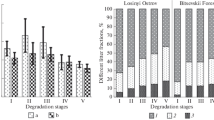Abstract
Based on a case study of Moscow forest parks Losinyi Ostrov and Bitsevskii Les, the paper presents a quantitative assessment of changes in the physical, chemical, and biological properties of soils on trails in these parks and in linear trailside (pritropinochnye) zones depending on the recreation load level. It is shown that soil properties differ in their sensitivity to recreation. The widths of impact zones range from 20 to 100 cm from the edges of trails depending on the sensitivity of the soil property, recreation load, and type of biogeocenosis.
Similar content being viewed by others
References
Ananeva, N.D., Susyan, E.A., Ryzhova, I.M., et al., Microbial biomass carbon and the microbial carbon dioxide production by soddy-podzolic soils in postagrogenic biogeocenoses and in native spruce forests of the southern taiga (Kostroma oblast), Eurasian Soil Sci., 2009, vol. 42, no. 9, p. 1029.
Baichibaeva, A.V. and Sobolev, N.V., Recreation effect of Olen’i Ruch’i national park onto soil, Agrar. Vestn. Urala, 2011, no. 4.(83).
Burova, N.V. and Feklistov, P.A., Antropogennaya transformatsiya prigorodnykh lesov (Anthropogenic Transformation of Suburban Forests), Arkhangelsk, 2007.
Vadyunina, A.F. and Korchagina, Z.A., Metody issledovaniya fizicheskikh svoistv pochv (Soils Physical Properties: Research Methods), Moscow, 1986.
GOST (State Standard) 3351-74: Drinking Water. Methods for Determining Taste, Odour, Color and Turbidity, Moscow, 1988.
GOST (State Standard) R 51232-98: Drinking Water. General Requirements for Organization and Quality Control Methods, Moscow, 2001.
Gryuntal’, S.Yu., Soil invertebrates under recreation forest utilization, in Vliyanie rekreatsii na lesnye ekosistemy i ikh komponenty (Recreation Effect onto Forest Ecosystems and Their Components), Moscow, 2004.
Shishov, L.L., Tonkonogov, V.D., Lebedeva, I.I., and Gerasimova, M.I., Klassifikatsiya i diagnostika pochv Rossii (Russian Soils: Classification and Diagnostics), Smolensk, 2004.
Kuznetsov, V.A., Ryzhova, I.M., and Stoma, G.V., Changes in the properties of soils of Moscow forest parks under the impact of high recreation loads, Eurasian Soil Sci., 2017, vol. 50, no. 10, p. 1225.
Kuznetsov, V.A., Ryzhova, I.M., Telesnina, V.M., et al., Quantitative assessment of the effect of recreation on vegetation, forest litter, and soil compactness in forest parks of Moscow, Moscow Univ. Soil Sci. Bull., 2015, vol. 70, no. 1, p. 17.
Kuznetsov, V.A., Stoma, G.V., and Bodrov, K.S., The condition of the mesopedobiont community in Moscow forest parks as an indicator of the recreational load and the formation of impact zones along footpaths, Moscow Univ. Soil Sci. Bull., 2014, vol. 69, no. 1, p. 40.
Kuibyshev, S.V., Soils biochemical properties change caused by recreation load in forest parks of Moscow region, Extended Abstract of Cand. Sci. (Agric.) Dissertation, Moscow, 1987.
Lysikov, A.B. and Sudnitsyna, T.N., Recreation effect onto soil from deciduous forest at Serebranyi Bor experimental forest district, Lesovedenie, 2008, no. 3.
OST (Branch Standard) 56-100-95: Methods and Measuring Units for Recreating Loads onto Forest Nature Complexes, Moscow, 1995.
Rysin, L.P. and Rysin, S.L., Urbolesovedenie (Urban Forest Science), Moscow, 2012.
Teoriya i praktika khimicheskogo analiza pochv (Soils Chemical Analysis. Theory and Practice), Vorob’eva, L.A., Ed., Moscow, 2006.
Shapochkin, M.S., Kiseleva, V.V., Obydennikov, V.I., et al., Complex method for measuring effect onto city and suburban forests, Nauch. Tr. Nats. Parka Losinyi Ostrov, 2003, no. 1.
Cakir, M., Makineci, E., and Kumbasli, M., Comparative study on soil properties in a picnic and undisturbed area of Belgrade Forest, Istanbul, J. Environ. Biol., 2010, vol. 31, pp. 125–128.
Cole, D.N., Impacts of hiking and camping on soils and vegetation, in Environmental Impacts of Ecotourism, New York, 2004.
Killham, K.A., Physiological determination of the impact of environmental stress on microbial biomass, Environ. Pollut., 1985, vol. 38, no. 3, pp. 283–329.
Malmivaara-Lämsä, M., Effects of recreational use and fragmentation on the understory vegetation and soil microbial communities of urban forests in Southern Finland, Doctoral Sci. Dissertation, Helsinki, 2008.
Mariella, M. and Norman, D., Recreational Use of Forests and Disturbance of Wildlife: a Literature Review, Edinburgh, 2012.
Author information
Authors and Affiliations
Corresponding author
Additional information
Original Russian Text © V.A. Kuznetsov, G.V. Stoma, I.M. Ryzhova, 2018, published in Vestnik Moskovskogo Universiteta, Seriya 17: Pochvovedenie, 2018, No. 2, pp. 19–29.
About this article
Cite this article
Kuznetsov, V.A., Stoma, G.V. & Ryzhova, I.M. Dependence of Changes in Soils on Trails and their Impact Zones from a Level of Recreational Impact in Forest Parks in Moscow. Moscow Univ. Soil Sci. Bull. 73, 60–70 (2018). https://doi.org/10.3103/S0147687418020059
Received:
Published:
Issue Date:
DOI: https://doi.org/10.3103/S0147687418020059



